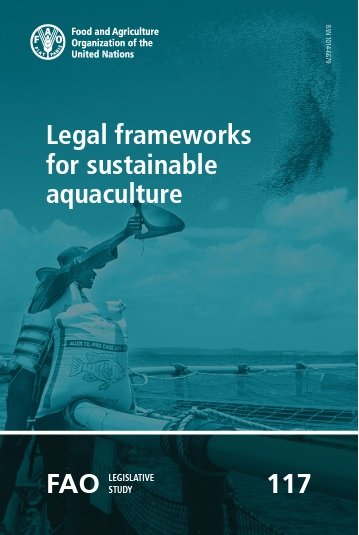
The aquaculture industry faces several challenges. At the same time, the sustainability of the aquaculture sector depends on a clean and healthy environment.
Likewise, climate change also poses a series of threats to aquaculture farms due to increased risks of flooding, coastal erosion, storms, among others.
In this sense, it is necessary for all countries to have an effective legal framework to help the aquaculture industry tackle all challenges and move towards sustainability.
The Food and Agriculture Organization of the United Nations (FAO) published a study where they identified the essential elements of a legal framework to promote sustainable aquaculture.
The study includes five chapters describing the normative frameworks at the international level that are most relevant to aquaculture. These include frameworks based on international law, indicative legal instruments and guidelines, and private aquaculture certification schemes.
Furthermore, other chapters contain an evaluation of national legal frameworks for aquaculture and the role and evolution of aquaculture legislation within those frameworks.
The importance of an adequate legal framework
As described in the guide, in many countries, the growth of aquaculture seems to have outpaced the development of legislation and legal frameworks to govern aquaculture activities.
Consequently, in many countries, the lack of specifically designed legislation for aquaculture has led to struggles in controlling access and aquaculture operations through outdated and marginally relevant laws, such as old fishing laws.
“In these circumstances, the lack of a conducive normative environment for aquaculture can be a significant limitation to the sector’s growth, both in developed and developing countries,” highlight the authors.
In this regard, the authors report that policymakers face the challenge of the great diversity within the aquaculture sector in terms of:
- The number of species and groups of species being cultivated: 622 “species” (including hybrids) were registered in the year 2018.
- The different aquatic environments where aquaculture takes place: freshwater, brackish water, and marine water.
- The diversity in terms of places where aquaculture species are cultivated: rice fields, dikes, tanks, raceways, ponds, recirculation systems, etc.
- The commercial and physical scale of aquaculture operations, which can vary from a single pond in family aquaculture to large commercial ponds for shrimp farming, as well as intensive production.
Aquaculture Legal Assessment and Revision Tool (ALART)
The study aims to act as a guide on the complexity of legal frameworks for aquaculture and also to serve as a background or resource document for the “Aquaculture Legal Assessment and Revision Tool” (ALART).
According to the guide, ALART has been developed as a detailed analytical tool to systematically assess national legal frameworks for aquaculture to identify possible gaps, weaknesses, and issues for potential reform, with a particular focus on environmental protection and animal and plant health.
The authors of the study hope that ALART becomes universally used.
Key elements of a legal framework for sustainable aquaculture
In this chapter, the document identifies and describes the key elements of an appropriate legal framework for responsible aquaculture development, one that promotes an environmentally, socially, and commercially sustainable aquaculture industry.
According to the ALART’s order, the study describes the key elements of the legal framework considering: fundamental policy issues, institutional arrangements, tenure arrangements (ownership), planning and approval/authorization, production – inputs, facility management, disease prevention and control, post-production, and inspection and compliance.
Conclusions
According to the authors of the study, a robust environmental legal framework is an essential prerequisite for the sustainable development of the aquaculture industry.
However, in the international legal framework, there are few specific references to aquaculture. Unlike fishing, there are no regional or global agreements on aquaculture.
“At the international level, the normative framework or rule-making consists entirely of indicative legal instruments, including, in particular, the Code of Conduct and its Technical Guidelines. Specifically, several supplements to the Technical Guidelines address different aspects of the sector. Several regional organizations have also adopted indicative legal guidelines for aquaculture, but some of the more detailed normative instruments derive not from intergovernmental bodies but from the private sector in the context of certification and eco-labeling schemes,” they conclude.
They also highlight that the legal framework for aquaculture at the national level is complex because it comprises laws or legal instruments that specifically address aquaculture, as well as a series of laws and legal instruments that establish the broader legal framework in which aquaculture takes place.
Reference (open access)
FAO. 2023. Legal frameworks for sustainable aquaculture. FAO Legislative Study No. 117. Rome. https://doi. org/10.4060/cc6018en

